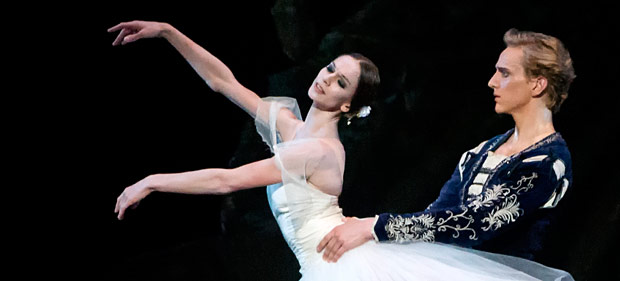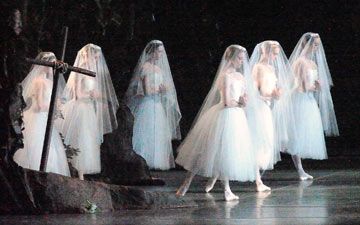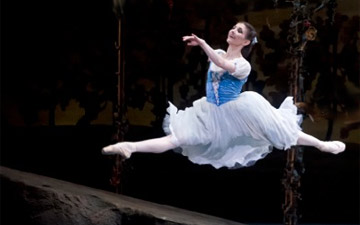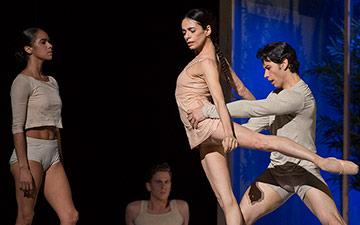
© Gene Schiavone. (Click image for larger version)
American Ballet Theatre
Giselle
New York, Metropolitan Opera House
17, 18, and 21 (mat and evening) June 2014
www.abt.org
Giselle Fever
Few nineteenth-century story ballets are as satisfying as Giselle, with its simple and poetic plot, compact structure and starkly contrasting moods. Its first act is as sunny and pastoral as the second is dark and spectral. Tragedy leads to desperation, resignation, and (possibly) redemption. In the first half the dancing is almost incidental; the second is all dance. And because of the ballet’s relative simplicity and reliance on mime, it gives the main couple, and even some of the secondary players, a chance to mold their characters according to their imagination. From performance to performance the nuances of the story change. Though it has its share of heart-stopping moments of pure dance, it’s not a ballet that dazzles with steps, but with the fullness of the dancers’ interpretation.
The current production at American Ballet Theatre, which dates from 1987, is still one of the company’s most successful. There is almost nothing one would change here, except perhaps to add a shade more light to the beginning of the second act. It would be nice to be able to make out the contours of the trees, the ruined abbey, and Giselle’s tomb. The color-saturated sets – rust and gold followed by bluish/black – are by Gianni Quaranta, an Italian designer originally from Arsiè, a small medieval village nestled at the foot of the Alps, not so different from the Rhineland setting of Giselle. The costumes, by Anna Anni, are unfussy and flattering. In the second act, Giselle’s ghostly white dress exposes her entire back and shoulders, a ballerina’s most expressive tool besides her feet, accentuating the curve of her neck. Adolphe Adam’s music, with its alpine melodies and descriptive passages – it practically tells the story – completes the scene (especially under the baton of David LaMarche).
This week I watched four Giselles, with four distinctly different casts. My only regret was that Herman Cornejo, scheduled to dance alongside Alina Cojocaru at the June 21 evening performance, was indisposed. He was replaced at the last minute by David Hallberg, whom I had seen earlier in the week (June 17) with Polina Semionova. The contours of his dancing have become only more pure over time; one marvels at his double air turns, perfectly vertical and landing in a neat fifth position, without a sound. The line of his leg in attitude, or lifted to the side as he balances on the tips of his toes, is a model of form. If anything, his dancing has become almost too pristine; the “desperate” solo at the end of the pas de deux was so beautifully danced, the two diagonals of gliding brisés so finely-etched, that they lacked the excitement his exhausted entrechats once had.
After three years with the Bolshoi, he is in many ways a changed dancer. His leaps are as airy and clear as ever, but his partnering has improved dramatically. The overhead lifts in act two revealed not the slightest strain. With Cojocaru this is hardly surprising – she’s light as a feather – but Semionova is both tall and long-of-limb, more of a challenge. With this proficiency has come a new confidence and engagement in the action onstage. His acting is still a work in progress, a willful act of his imagination; in other words, one feels him thinking rather than feeling, but this too is an art. His Albrecht is a creation of his intelligence. Seeing him dance the role twice in a week reveals just how many details he changes with each performance.

© Gene Schiavone. (Click image for larger version)
The pairing with Polina Semionova brought out a youthful ardor and playfulness in Hallberg. Besides her impeccable technique, Semionova’s chief characteristic is a winning sweetness, a warmth that creates an immediate bond with her partner. She’s well-matched with Hallberg in size and physique – the lines of their arms and legs match beautifully – though she’s hardly the sickly waif we’re used to in this role. And she doesn’t try to be. Her Giselle is a girl in full bloom, trusting and ready for love. In the second act, she is transformed into a benevolent spirit, even more loving in death than in life. As the bells toll at the end of the ballet, she leaves with a note of hope, as if releasing Albrecht from his penance.
With Cojocaru the story changes. There is no doubt that she is one of the great actresses of the ballet stage; in fact, she seems to be making up the story as she goes along. One imagines she must be slightly unsettling to dance with, with her spontaneous pauses, glances, and unpredictable reactions. Alongside her febrile, excitable Giselle, Hallberg’s Albrecht took on a different hue. The ballet became less the story of a mutual attraction and more that of a nobleman intrigued by the inner life of a volatile young girl. As for Cojocaru’s Giselle, how could she not fall in love with this blonde idol towering over her? The two seemed to hail, not from different social classes, but from different universes.
Besides her spontaneity, what one notices about Cojocaru is her phrasing, the way she plays with timing, cutting things short or extending them to create a sense of excitement. At this point in her career, there are also aspects of her technique that are less than full-throttle. Her diagonal of hops on pointe, while the other leg traces circles in the air, hardly travels forward. The receding series of beaten jumps that so often creates the illusion of floating backward into space (like a spirit) doesn’t have quite enough force. But she compensates with other aspects: the ultra-legato phrasing of the pas de deux, a series of scurrying bourrées into the wings that make her feet look like a blur. Cojocaru has more than earned the right to pick her battles.

© Gene Schiavone. (Click image for larger version)
The company is dancing beautifully this season; with fewer stars flitting in and out, one can see its strengths all the more clearly. At each performance of Giselle, the dancing of the spirits (Wilis) in the second act was particularly beautiful. Pliant, soft backs and arms moving, reflecting the dynamics of the music; arabesques all held at the same height, creating a stirring effect as the cohort advances in intersecting lines across the stage. (Could the expressiveness of their backs have anything to do with the fact that they just danced Frederick Ashton’s Cinderella?)
There were strong, individualized performances among the supporting characters. The three women who danced the role of Myrta, queen of this ballet’s nocturnal realm – Devon Teuscher, Veronika Part, and Stella Abrera – were authoritative, each in her own way. The tiny, stich-like bourrées with which Teuscher traversed her kingdom made the audience hold its breath, as did her smooth, perfectly horizontal glides in arabesque (and her stillness in sous-sus). As usual, the deep bend in Part’s spine, and the voluptuousness with which she uses her shoulders, caught the eye, combined with her surprisingly soaring leap (and soft landings). Abrera was commanding and refined both in her bearing and in her crisply-articulated footwork. In the role of Hilarion, Giselle’s eternally faithful, eternally thwarted admirer, Thomas Forster was ardent and slightly thuggish; in the second act, his long arms sculpted the air in beautiful spirals as he careered toward his death. And as Zulma – one of Myrta’s deputies – both April Giangeruso and Stephanie Williams displayed remarkable amplitude and upper-body fluidity.
The young casts, too, made a powerful impact. Isabella Boylston, in her New York début (June 18 matinée), was a fresh, unmannered Giselle, whose hops on pointe and buoyant jumps – lingering in the air at the apex – gave full expression to the character’s love of dance. She took her time in the mad scene, gradually receding from the reality of the people who surrounded her. And she took chances: transformed into a Wili, she dramatically slowed down certain passages, such as the raising of her leg into an arabesque penchée, so that the extremity of her physical control became a manifestation of her spiritual state. Her partner, James Whiteside, also performing the role for the first time in New York, was a rough-edged Albrecht, more petulant than noble; his lines are not always as pristine as they could be. And yet his able partnering and musicality are an asset. In the series of desperate entrechats of his final solo, it was particularly striking to see how his feet beat together precisely with the internal beats in the music.

© Gene Schiavone. (Click image for larger version)
The most surprising performance of the week, though, was the début of Alexandre Hammoudi, alongside Hee Seo (June 21, matinee). Seo’s Giselle has deepened considerably since her début in 2011. Like Hallberg, she is a dancer of astonishingly limpid lines. She’s also expressive without being particularly detailed; she simply offers her face to the light, eyes glistening, and one senses a well of emotion lying beneath the serene exterior. Hammoudi is similar, in a way: a surprisingly natural actor who uses stillness to powerful effect. His Albrecht has an innate authority and an eye for feminine beauty. There is no mystery as to why he’s trawling the nearby villages. At times, in this performance, he looked at Seo’s Giselle as if he might gobble her up in one gulp. When her friends returned from the harvest, he plucked a grape from one of their baskets with the nonchalance of an experienced seducer. In his long, drawn-out entrance in the second act, accompanied by a sorrowful cello – a moment of pure poetry – he looked like an anti-hero in a gothic novel: dark, brooding, tormented. Hammoudi’s dancing has weight and a pliant lushness, but his stamina is not quite what it should be. By the end of the ballet, he was showing signs of strain. But if he can build up his technique, he has the makings of a truly great Albrecht.

















[…] is like seeing four different ballets—one of the reasons for this ballet’s enduring appeal. Here’s my review, for DanceTabs, of four contrasting casts at ABT: Polina Semionova/David Hallberg, Isabella […]
Wonderful review! It really makes the performances come alive. In the last 56 years I’ve seen Vishneva-Corella and Osipova-Hallberg in Giselle. Both performances were phenomenal and radically different. How I wish I could express my own Giselle fever in a few more perfs. Thanks again for your astute and thought provoking commentary.
Dear Marta, I remember that day! In fact, I wrote about it: https://dancetabs.com/2012/05/american-ballet-theatre-giselle-new-york/